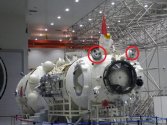The grasping end attachments seems very similar to the ISS Canadarm 2’s latching end effector: . The arm on the Chinese station core module does seem to be very similar to the Canadarm 2 overall in concept and execution.
According to the Russians, the arms on the two laboratory modules yet to be flown were supplied by Rosocosmos and were identical to the Ljappa arms used in the Mir station.
According to the Russians, the arms on the two laboratory modules yet to be flown were supplied by Rosocosmos and were identical to the Ljappa arms used in the Mir station.
Last edited:

